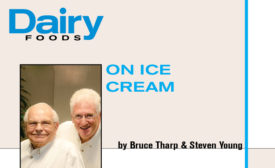Articles by Steve Young
Declarable reduction of ‘sugars’ while retaining sensory appeal is possible.
Read More
Formulating ice cream with novel functional ingredients
As complex new ingredients are introduced to the ice cream mix, much remains to be understood about influences on physical/chemical properties.
April 26, 2019
Consider ice cream mix processing advances
Novel approaches offer the potential to improve ice cream mix processing, but processors will want to keep a close eye on sensory appeal in the evaluation process
February 7, 2019
Manage ice cream composition development and changes
Multiple indices based on sound science and technology can be used to guide the reformulation process
September 10, 2018
Ice cream
Successfully flavor ice cream in a cost-competitive environment
The management of flavor-related costs also requires a focus on elements that influence body, texture, sweetness and other factors.
May 9, 2018
Improve nonstandardized frozen desserts
The creation of ice cream-like functionalities and sensory appeal involves new challenges on multiple fronts
April 3, 2018
Revisiting the clean-label ice cream conundrum
The obstacles to creating clean-label ice cream seem very much the same as they did a year ago.
February 7, 2018
Use the right sweetener systems, stabilizers to avoid heat shock in gelato
We call the relatively high temperatures in a gelato cabinet the ‘danger zone.’ To mitigate heat shock, use the right sweetener systems and stabilizers.
September 11, 2017
Strategies for managing ‘added sugars’
Formulation options include use of high-intensity sweeteners. Processing techniques include using pre-aeration of the mix to produce smaller, more stable air bubbles.
May 8, 2017
Novel ingredients, process technologies reduce stress in ice cream
It is important to minimize and stabilize the size of ice crystals. Pre-aeration promotes small air bubbles with inherent resistance to growth during manufacturing and handling.
April 5, 2017
Get our new eMagazine delivered to your inbox every month.
Stay in the know on the latest dairy industry trends.
SUBSCRIBE TODAYCopyright ©2024. All Rights Reserved BNP Media.
Design, CMS, Hosting & Web Development :: ePublishing

